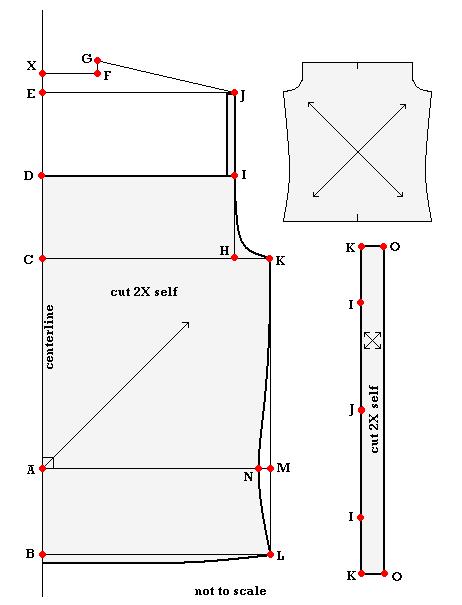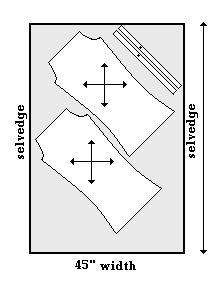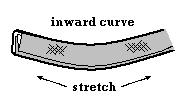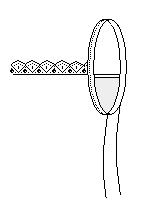 Featured: Ella Moss Camisole
Featured: Ella Moss Camisole
Lacy lingerie-inspired camisoles are the hottest tops for summer. Treat yourself to a fluid bias-cut top, similar to this one by L.A.’s Pamella Protzel for Ella Moss. The “bias-cut” technique is used by designers for cutting clothing to utilize the greater stretch in the bias or diagonal direction of the fabric, causing it to accentuate body lines and curves and drape softly, thereby eliminating the need for darts.
You will need:
- Approx. 1 ½ yds. [1.4 m] of fashion fabric, 45” [114cm] wide.
- ½ yd. [0.5 m] of insertion lace, 1” – 2″[25-50 mm] wide.
- Coordinating thread
- Kraft paper
MEASUREMENTS
Bust – measure around fullest part of chest just under the arms.
Armhole Depth – measure vertically from top of shoulder to armpit level.
Neck – measure around base of neck.
Back width – measure across shoulder blades from armpit to armpit.
Back waist length – measure vertically from nape of neck to waist line.
PATTERN

Fold paper in half lengthwise. Plot X at the top of the foldline.
Along the foldline, square across from X at a 90° angle.
X-A = back waist length + ⅜” [10mm]; square across.
A-B = 6” [15.2 cm]; square across.
X-C = armhole depth + ⅝” [15mm]; square across.
X-D = half the measurement X-C; square across.
X-E = one fifth the measurement X-D; square across.
X-F = one sixth the neck size; square up.
F-G = ¾” [20mm].
C-H = half of the back width – ⅝” [15mm]; square up to locate I and J at the intersection of lines.
Join G to J with a straight line.
C-K = quarter of the bust measurement – ⅝” [15mm]; square down to locate M on waist line and L on high-hip line.
Draw an armhole curve from I to K as shown.
M-N = 1 ⅝” [45mm]; shape sideseam with a smooth curve between K and L.
Shape the hemline at a 90° angle from L, missing B by ⅜” [10mm].
Draw a square box with 2 sides located at A. Draw a grainline through opposite corners of the box.
For shoulder strap, measure distance from J-I-K. Double the amount and plot it on a straight line.
K-O = 1 ⅝” [40mm]; join O-O and K-O with a straight line.
Draw a grainline at 45° to K-O.
Add seam allowance to body pieces except for armhole & shoulder straps.
Cutting Tip: Widen seam allowances for bias-cut. Although bias cuts don’t fray, the fibers on cut edges relax and open up, so even half-inch away from a cut edge isn’t an accurate stitching line. To your pattern pieces, add 1-1/2-inch-wide seam allowances. Use 1/2-inch seam allowances at the neckline for the lace trim. Always mark stitching lines with thread as soon as the fabric is cut, before removing the pattern pieces. Once sewing and pressing are done, seams can be trimmed.
 CUTTING
CUTTING
Front – cut 1X self
Back – cut 1X self
Shoulder strap – cut 2X self (make longer than needed for shaping)
Trim – Cut length of lace to match width at top of the garment.
Fitting Tip: Pin/baste the fabric pieces together and try it on before you sew the garment. This is called trial fitting, and it allows you the chance to define the fit of the bias cut with better accuracy and mark the stitching lines. If you’re sewing a garment for someone else, have them try on the fitting. Allow enough “ease” to slip over the head.
ASSEMBLY
- Sew a narrow double-rolled hem across the top edge of the back piece turning it to the inside.
- Fold the top edge of the front piece to the outside and stitch along folded edge. Trim seam allowance close to stitching. Lay insertion lace on top of finished edge and edge-stitch across the bottom of the trim.
 With right sides together, align and match front to back at side seams. Stitch 1” [25mm] from top edge on stitching line. Stay-stitch the armholes.
With right sides together, align and match front to back at side seams. Stitch 1” [25mm] from top edge on stitching line. Stay-stitch the armholes.- For shoulder straps, fold the strap pieces in half along its length with wrong sides together to create a bias binding; press lightly. Turn in cut edges of binding to crease of foldine; press. Re-fold center crease and press.
 Pre-shape the bias binding to match armhole edge of garment by stretching the two folded edges to match the shape of the inward curve of the armhole.
Pre-shape the bias binding to match armhole edge of garment by stretching the two folded edges to match the shape of the inward curve of the armhole.- Pin/baste binding to armhole, beginning at side seam, and extend the binding as a loop for the shoulder strapping as need. Continue by joining ends on straight grain; turn in one and lap over the other to complete. Stitch the open edge of the binding to the armhole and continue stitching to make the shoulder strap.
- Baste your bias-cut garment together along the side seams and drape onto a dressform or let it hang for a day or 2 before you use your sewing machine to complete the seams. This will help to smooth your seams out and encourages the fabric to stretch naturally. Thread-mark the stitching line again if necessary.
- Stitch the side seams following the basted stitching line. When stitching seams on your bias-cut garment, be sure to go slowly and allow the fabric to take its natural shape, rather than pulling it taut as you pull it through the sewing machine. It is best to stitch the seams in short bursts, allowing the fabric to relax and take its natural shape each time before continuing. Likewise, once the seams are stitched, allow the garment to hang for a while before you hem the bottom. This will allow the garment to develop a natural fall and ensure that the hems are straight and smooth. When ironing the hem, do not move the iron side to side along the hem as you would with a normal cut garment; instead, move the iron along the line of the bias.
- Trim excess away in seam allowance. (I prefer to pink the seam allowance rather than overlock the raw edge.)
- Make a narrow rolled edge on the hemline.
Bias-cut garments don’t wrinkle as easily as straight-grain garments do, but they can “grow” on a hanger, so always store them folded and flat.
August 11, 2009 at 12:54 am
Wonderful! Thank you so much:)
August 11, 2009 at 2:23 pm
I love your blog. I’ve learned how to draft basic garment patterns, but sometimes figuring out how an intricate design translates to a flat pattern can be a bit tricky. That’s when my husband tells me I go into “fabric engineer mode.” Because of your blog, I have a little less smoke coming out of my ears. 🙂
August 11, 2009 at 8:46 pm
Whoop!!! Camisole love 🙂
August 11, 2009 at 10:12 pm
[…] BIAS-CUT CAMISOLE « Weekend designer […]
August 12, 2009 at 1:48 pm
I really like this one– so simple, and could be used for so many things. My one question is, did you use a knit or a woven for this?
August 12, 2009 at 2:42 pm
This is a bias-cut design. Only a woven fabric can be bias cut. Select one that has a soft and fluid “hand” (feel).
However the same pattern draft may be used to make it from a knit fabric. Remember to change the direction of the grainline and make it parallel to the center line. The knit should be cut so that the direction of greatest stretch is along the girth (width) of the pattern.
WD
August 15, 2009 at 2:23 am
This is absolutely gorgeous – what a fantastic idea!
August 19, 2009 at 7:23 am
Thanks for this lovely pattern and your wonderful & inspirational website!
November 12, 2009 at 12:01 pm
[…] Bias-Cut Camisole […]
February 8, 2010 at 10:33 am
Thank you for posting this lovely pattern – It is just what I am looking for!
March 10, 2010 at 3:21 am
Yes! I’ve been looking all over the place for a top like that for this summer.
July 14, 2010 at 7:45 am
[…] Bias-Cut Camisole […]
October 5, 2010 at 7:41 pm
[…] Blog Weekend designer wird eine Anleitung gegeben, wie man selber das Schnittmuster für ein einfaches Trägerhemdchen […]
March 4, 2014 at 11:25 pm
[…] As for me, I have made 2 Plantain t-shirts (so comfortable!), a pair of self-drafted jeans, and a bias cut cami. […]
September 19, 2019 at 5:41 am
[…] […]